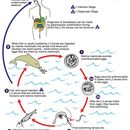en
names in breadcrumbs


Nematodes within the Secernentea have phasmids, which are unicellular glands. Phasmids likely function as chemoreceptors. Females may produce pheromones to attract males.
Nematodes in general have papillae, setae and amphids as the main sense organs. Setae detect motion (mechanoreceptors), while amphids detect chemicals (chemoreceptors).
Communication Channels: tactile ; chemical
Other Communication Modes: pheromones
Perception Channels: tactile ; chemical
The life cycle of A. simplex begins when eggs are passed through the feces of its definitive host. The definitive hosts of this species include many marine mammals such as whales, porpoises, and seals. Once the eggs are passed, they hatch into second stage juveniles. The juveniles must be consumed by an intermediate host, usually a euphausiid crustacean, for the life cycle to continue. Physical changes to the environment that are specific to the hemocoel of the crustacean probably signals the worms to develop into a third stage juvenile. Predators of crustaceans, usually fish or squid, become infected by A. simplex after eating an infected crustacean. Because A. simplex does not undergo any development inside the gut of the fish or squid, these predators are considered paratenic hosts of the nematode. The life cycle is completed after the paratenic host is ingested by a definitive host. Inside its final mammalian host, the worm develops into a sexually mature adult. Because A. simplex eggs are shed from the host throughout the year, they may develop and hatch at any time, thus acquisition of infection by hosts is non-seasonal.
While the above mentioned life cycle is accepted by many scientists, there is considerable evidence that two molts actually occur during development in the egg of A. simplex and that it is the third stage juvenile which hatches from the egg.
Anisakis simplex is of much medical importance because of the severe allergic reactions and gastrointestinal symptoms it causes in humans after eating or handling infected fish or crustaceans. These reactions include chronic uticaria (skin rashes), gastric ulcers, and anaphylaxis (a hyper-immune response). These symptoms are termed anisakiasis and are especially prevalent in countries where it is common to eat raw or undercooked fish. Populations of fishermen are also at risk of developing anisakiasis as well as developing occupational asthma caused by the inhalation of antigens from A. simplex. However, even people who take special precautions when handling and preparing their fish are at risk of developing anisakiasis. It has been reported that A. simplex can survive at temperatures of over 65 degrees Celsius inside a microwave oven.
Negative Impacts: injures humans (causes disease in humans )
This parasitic worm can be found in crustaceans, squid, fish, and marine mammals in oceans and seas from the tropics to the arctic and antarctic regions.
Ecosystem Impact: parasite
Species Used as Host:
Like other ascaridid nematodes, Anisakis simplex feeds on the gut contents of its definitive host as an adult. Pharyngeal glands and intestinal epithelium produce digestive enzymes. Extracellular digestion begins within the lumen and is finished intracellularly.
Animal Foods: body fluids
Primary Diet: carnivore (Eats body fluids)
Anisakis simplex has a wide range of hosts throughout its life cycle and an equally large geographic range. This parasitic worm can be found in crustaceans, squid, fish, and marine mammals in oceans and seas from the tropics to the arctic and antarctic regions.
Biogeographic Regions: nearctic ; palearctic ; neotropical ; oceanic islands ; arctic ocean ; atlantic ocean ; pacific ocean
The immediate habitat of Anisakis simplex is inside the hemocoel of its crustacean intermediate host where the parasite develops into its third stage juvenile. Generally it is inside the gut of its paratenic and definitive hosts as a third stage juvenile and adult respectively. Second stage juveniles are able to live freely in sea water until becoming ingested by a crustacean.
The more indirect habitat of A. simplex is the marine environment where its hosts live.
Habitat Regions: saltwater or marine
Aquatic Biomes: pelagic ; benthic ; reef ; coastal ; brackish water
Other Habitat Features: estuarine ; intertidal or littoral
Members of the Phylum Nematoda are wormlike, have a pseudocoel and complete digestive system. Their bodies are covered with a non-cellular cuticle composed of collagen and other compounds which is secreted by the epidermis. The cuticle has three main layers and is shed four times throughout their life cycle. The nematode psuedocoel, filled with fluid, functions as a hydrostatic skeleton. Somatic musculature, composed of longitudinal muscles, acts against the stretching and compression of the cuticle to produce movement. Connected to the main body of muscles are dorsal and ventral longitudinal nerve cords.
Like most other ascaridid nematodes, A. simplex possesses three protruding lips around its mouth opening. These lips are poorly developed in juvenile stages, but contain inner labial papillae, which may function as combined chemomechanosensory receptors in adults. Male ascaridids possess simple spicules used to hold the female genital pore open against hydrostatic pressure during copulation.
Anisakis simplex juveniles range in size from less than 5 mm as second stage juveniles to more than 30 mm in their fourth stage.
Range length: 5 to 30 mm.
Other Physical Features: ectothermic ; heterothermic
Sexual Dimorphism: female larger; sexes shaped differently
These parasites are usually not preyed on directly, but are ingested from host to host. Larval mortality is high due to its inability to reach a suitable host.
Inside its final mammalian host, the worm develops into a sexually mature adult. Females may produce a pheromone to attract males. The male coils around a female with his curved area over the female genital pore. The gubernaculum, made of cuticle tissue, guides spicules which extend through the cloaca and anus. Males use spicules to hold the females during copulation. Nematode sperm are amoeboid-like and lack flagella.
Key Reproductive Features: gonochoric/gonochoristic/dioecious (sexes separate); sexual ; fertilization (Internal ); oviparous
Parental Investment: pre-fertilization (Provisioning)